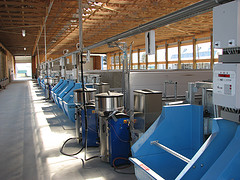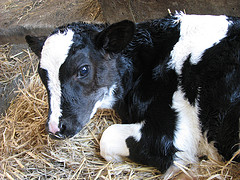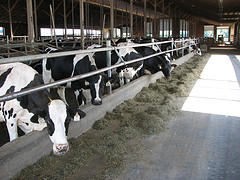Producers spend millions of dollars building indoor housing for dairy cattle with the aim of providing a comfortable environment for their animals. Unfortunately, this housing does not always function well from the perspective of the cow – poorly designed and maintained facilities can cause injuries and increase the risk of lameness. Lameness is now widely accepted as one of the most important welfare and production problems in modern dairy herds.
Benchmarking is one method to promote the adoption of best practices. UBC’s Animal Welfare Program partnered with key players in the BC dairy industry (for work on farms in British Columbia; BC) and with Novus International Inc. (St. Charles, MO; for work on US farms) to benchmark measures related to cow comfort (e.g. lameness and leg injuries) as well as facility design and managment (including stall dimensions, bedding practices, and stocking density). Researchers visited 121 dairy farms throughout North America. The results in this Research Report describe a comparison of 42 farms in BC, 39 farms in California (CA) and 40 farms in the North Eastern US (New York, Vermont and Pennsylvania; NE). Each farm was visited twice, with approximately 3 to 5 days between visits. The same trained observers performed all animal and facility-based measures on all farms in each of the three regions. One group of high-producing and primarily multiparous cows was assessed on each farm.
The primary aim of this benchmarking was to provide participating dairy farmers with data from their own farm, together with averages from other farms in their region, so they could identify areas of success and areas where work was still needed. Each farmer was provided a confidential report they could use (ideally together with their farm staff, veterinarian, hoof trimmer and nutritionist) to develop tailored solutions for their own farm.

Figure 1. Prevalence of clinical lameness in British Columbia (BC), California (CA) and the North Eastern US (NE), farms ranked lowest to highest.
This Report focuses on the lameness results from this large benchmarking study. Cows were scored as not lame (gait score of less than 3 on a 1 to 5 scale), clinically lame (gait score 3 or greater but less than 4), or severely lame (gait score of 4 or 5). A total of 17,887 cows were gait scored in this study. The three regions varied in rates of lameness; prevalence of clinical lameness averaged 28% in BC, 31% in CA, and 55% in NE (Figure 1), and prevalence of severe lameness averaged 7% in BC, 4% in CA, and 8% in NE.
More importantly, within each region lameness varied greatly, with some farms having very low rates while on other farms more that half the cows assessed were clinically lame. The results show the potential for sharing best practices when it comes to lameness prevention, particularly within a region where producers share similar opportunities and constraints. A second aim of our benchmarking work was to identify housing and management options that lead to lower rates of lameness. Variation in lameness can be explained in part by how barns are designed and managed, but these factors vary among regions due to differences in tradition, barn builders, and availability of materials and bedding. This means the factors associated with lameness also vary among regions.
For example, in BC we found that the mean prevalence of severe lameness (gait score 4 or 5) was higher on farms where cows were on mattresses (9% of cows severely lame) versus farms that using deep-bedded stalls (4% of cows severely lame).
We also found differences in factors associated with lameness between NE and CA. In NE, where many farms used mats or mattresses with little bedding, the occurrence of lameness was reduced by half on farms using deep bedding or providing dry cows access to pasture. In CA, all farms used deep-bedded stalls and almost all farms provided outdoor access (typically to a well-bedded dry lot). Likely because of these conditions, rates of lameness were much lower in CA than in NE. Within the CA farms, lameness was lowest on farms where stalls were kept clean (i.e. not contaminated with feces) and on farms that used rubber in the alley leading to the milking parlour. These results illustrate that when one limiting factor is addressed (e.g. by changing from mattresses to deep bedding) new factors can be identified (such as the benefits of rubber flooring). In both CA and NE we found that larger farms had lower rates of lameness. We believe that this positive effect of larger herds was due to more professionalized management on many large farms, including the availability of staff specifically responsible for lameness and hoof health. Further research is needed to document management factors related to this protective effect of herd size.
Measuring lameness takes effort and skill. Most people with cow experience can identify animals that are severely lame, but identifying clinically lame animals requires some training, much like body condition scoring of cattle. One of the take home messages from our work is how much value producers can gain from getting objective information for their farms. We can provide this service for farms we have visited, but ultimately more farmers and farm workers need to become competent at gait scoring – you can’t manage for lameness unless you can measure it, and routine gait scoring allows you to do this.
In summary, across regions, farms that use well-maintained, deep-bedded stalls had fewer lame cows. Benchmarking programs, like the one we described here allow farmers to compare data from their farms with the averages from other farms within their region. Farmers can use this data, together with the recommendations described here and elsewhere, to develop tailor-made solutions to problems with lameness. We view customized solutions as essential, given the different challenges and opportunities faced by different farms.
For further information please Email marina.vonkeyserlingk@ubc.ca or dan.weary@ubc.ca. This report is based on three papers published in the Journal of Dairy Science (von Keyserlingk et al. 2012. J. Dairy Sci. 95:7399-7408; Chapinal et al. 2013. J. Dairy Sci.96: 318-328; Ito et al. 2010. J. Dairy Sci. 93 :3553–3560). We thank Novus International Inc., Artex Barn Solutions Ltd., Clearbrook Grain and Milling Co. Ltd., Nutritech Solutions Ltd, Ritchie-Smith Feeds Inc. and Unifeed who collaborated in the work described in this report. General funding for the Animal Welfare Program is provided by NSERC, the Dairy Farmers of Canada and many others listed at http://awp.landfood.ubc.ca/





